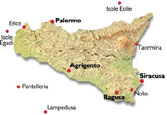|
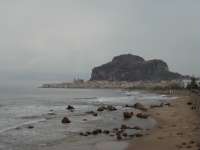 The original town was on the huge rock, where - if you are fit and energetic - you can see on the way up the remains of the so-called "Temple of Diana". These consist of Greek additions to a much older megalithic structure. It was a Sikel stronghold before becoming Greek, probably somewhere around 400 BC - their name for the place, Kephaloidion, means "the head-like object", and refers obviously to the shape of the great outcrop which dominates the town. In the 9th century AD it became Arab, and in the 12th century was re-founded by the Norman Roger II. The great cathedral was built, not as the legend has it, as a thanksgiving for his survival after being shipwrecked on the coast, but for largely political reasons - in the cause of pressing his quarrel with the Pope Innocent III. It was consecrated by an anti-Pope. The original town was on the huge rock, where - if you are fit and energetic - you can see on the way up the remains of the so-called "Temple of Diana". These consist of Greek additions to a much older megalithic structure. It was a Sikel stronghold before becoming Greek, probably somewhere around 400 BC - their name for the place, Kephaloidion, means "the head-like object", and refers obviously to the shape of the great outcrop which dominates the town. In the 9th century AD it became Arab, and in the 12th century was re-founded by the Norman Roger II. The great cathedral was built, not as the legend has it, as a thanksgiving for his survival after being shipwrecked on the coast, but for largely political reasons - in the cause of pressing his quarrel with the Pope Innocent III. It was consecrated by an anti-Pope.
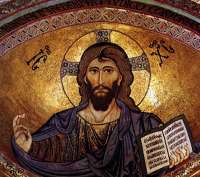 On my first visit to Cefalù in November 1993, I found myself completely alone in the mighty building. It was about 4.30pm, and beginning to get dark; the only sound was the muffled shouting of young footballers on the square outside. The Pantocrator is so much more awe-inspiring than the later one at Monreale, and the whole building has a numinous atmosphere that is completely missing in Monreale. No meanness of lighting, no school parties, no jabbering custodians; the bareness of the nave reminded me of Torcello in the Venetian lagoon - but I guess few people are lucky enough ever to have this jewel to themselves! On my first visit to Cefalù in November 1993, I found myself completely alone in the mighty building. It was about 4.30pm, and beginning to get dark; the only sound was the muffled shouting of young footballers on the square outside. The Pantocrator is so much more awe-inspiring than the later one at Monreale, and the whole building has a numinous atmosphere that is completely missing in Monreale. No meanness of lighting, no school parties, no jabbering custodians; the bareness of the nave reminded me of Torcello in the Venetian lagoon - but I guess few people are lucky enough ever to have this jewel to themselves!
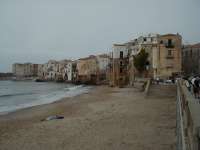
The only other thing I really wanted to see in Cefalù was the Museo Mandralisca, which contains the 4th century BC Greek plate showing a fishmonger chopping a tuna, and Antonello da Messina's enigmatic Portrait of a Man. I saw neither as the Museum was closed. When I told Daphne later, she just laughed. Apparently she used to offer a prize to any of her guests who managed to gain entry! Sure enough, it was still closed when I spent a week in Cefalù with my wife in 2000.
If you continue downhill past the barricaded museum and turn left, you will come to the so-called Lavatory (Lavatoio) - a salt spring converted by the Arabs into a washing place. There is a tradition connecting the place with Daphnis, inventor of pastoral poetry, whose salty tears allegedly created the spring, but I can't find any source which associates this myth with Cefalù.
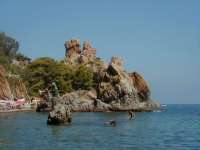 Cefalù is also a fine seaside resort - now more popular as a package tour destination than Taormina. It lacks some of Taormina's glamour, and its views, but it is right on a fine sandy beach. And I liked the cheerful atmosphere of the place - lots of people laughing and shouting in the streets. My wife and I stayed in the Hotel Kalura which is actually on a rocky beach round the corner to the east of the town. It was fine to be in Cefalù, but the hotel cannot be recommended to the serious traveller - "international" cuisine is on offer, and the main terrace is entirely given over to weddings, and is thus normally inaccessible to guests. I much preferred the simple Locanda Cangelosi I stayed in in 1993, in a large 3-bedded room overlooking the Via Umberto, the Rocca and the Fountain. It helped that it happened to be right opposite where I'd parked. Cefalù is also a fine seaside resort - now more popular as a package tour destination than Taormina. It lacks some of Taormina's glamour, and its views, but it is right on a fine sandy beach. And I liked the cheerful atmosphere of the place - lots of people laughing and shouting in the streets. My wife and I stayed in the Hotel Kalura which is actually on a rocky beach round the corner to the east of the town. It was fine to be in Cefalù, but the hotel cannot be recommended to the serious traveller - "international" cuisine is on offer, and the main terrace is entirely given over to weddings, and is thus normally inaccessible to guests. I much preferred the simple Locanda Cangelosi I stayed in in 1993, in a large 3-bedded room overlooking the Via Umberto, the Rocca and the Fountain. It helped that it happened to be right opposite where I'd parked.
The Trattoria Arkade is supposed to be the place to eat - but it has proved a similar experience to the Museo Mandralisca. I'd recommend the Ostaria del Duomo, both for the food and the magnificent position.
|

